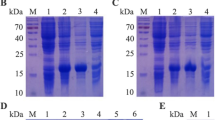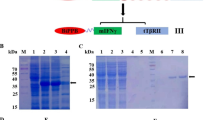Abstract
Excessive production of transforming growth factor-β1 (TGF-β1) and its binding to transforming growth factor-β receptor type II (TGF-βRII) promotes fibrosis by activation of the TGF-β1-mediated signaling pathway. Thus, the truncated extracellular domain of TGF-βRII (tTβRII) is a promising anti-fibrotic candidate, as it lacks the signal transduction domain. In this work, the native N-terminal tTβRII was prepared as a His-SUMO fusion protein (termed His-SUMO-tTβRII) in Escherichia coli strain BL21 (DE3). His-SUMO-tTβRII was expressed as a soluble protein under optimal conditions (6 h of induction with 0.5 mM IPTG at 37 °C). His-SUMO-tTβRII was purified by Ni–NTA resin chromatography, and then cleaved with SUMO protease to release native tTβRII, which was re-purified using a Ni–NTA column. Approximately 12 mg of native tTβRII was obtained from a one liter fermentation culture with no less than 95% purity. In vivo studies demonstrated that tTβRII prevented CCl4-induced liver fibrosis, as evidenced by the inhibition of fibrosis-related Col I and α-SMA protein expression in C57BL/6 mice. In addition, tTβRII downregulated phosphorylation of SMAD2/3, which partly repressed TGF-β1-mediated signaling. These data indicate that the His-SUMO expression system is an efficient approach for preparing native tTβRII that possesses anti-liver fibrotic activity, allowing for the large-scale production of tTβRII, which potentially could serve as an anti-fibrotic candidate for treatment of TGF-β1-related diseases.





Similar content being viewed by others
References
Antoniou G, Papakyriacou I, Papaneophytou C (2017) Optimization of soluble expression and purification of recombinant human rhinovirus Type-14 3C protease using statistically designed experiments: isolation and characterization of the enzyme. Mol Biotechnol 59:407–424
Bai G, Yan G, Wang G, Wan P, Zhang R (2016) Anti-hepatic fibrosis effects of a novel turtle shell decoction by inhibiting hepatic stellate cell proliferation and blocking TGF-beta1/Smad signaling pathway in rats. Oncol Rep 36:2902–2910
Bradford MM (1976) A rapid and sensitive method for the quantitation of microgram quantities of protein utilizing the principle of protein-dye binding. Anal Biochem 72:248–254
Butt TR, Edavettal SC, Hall JP, Mattern MR (2005) SUMO fusion technology for difficult-to-express proteins. Protein Expr Purif 43:1–9
Douglass A, Wallace K, Koruth M, Barelle C, Porter AJ, Wright MC (2008) Targeting liver myofibroblasts: a novel approach in anti-fibrogenic therapy. Hepatol Int 2:405–415
Farrar CT, Gale EM, Kennan R, Ramsay I, Masia R, Arora G, Looby K, Wei L, Kalpathy-Cramer J, Bunzel MM, Zhang C, Zhu Y, Akiyama TE, Klimas M, Pinto S, Diyabalanage H, Tanabe KK, Humblet V, Fuchs BC, Caravan P (2017) CM-101: type I collagen-targeted MR imaging probe for detection of liver fibrosis. Radiology 287:581–589
Gao X, Chen W, Guo C, Qian C, Liu G, Ge F, Huang Y, Kitazato K, Wang Y, Xiong S (2010) Soluble cytoplasmic expression, rapid purification, and characterization of cyanovirin-N as a His-SUMO fusion. Appl Microbiol Biotechnol 85:1051–1060
Hagler MA, Hadley TM, Zhang H, Mehra K, Roos CM, Schaff HV, Suri RM, Miller JD (2013) TGF-beta signalling and reactive oxygen species drive fibrosis and matrix remodelling in myxomatous mitral valves. Cardiovasc Res 99:175–184
Hahn JM, McFarland KL, Combs KA, Supp DM (2016) Partial epithelial-mesenchymal transition in keloid scars: regulation of keloid keratinocyte gene expression by transforming growth factor-beta1. Burns Trauma 4:30
Hernandez-Canaveral I, Gonzalez J, Lopez-Casillas F, Armendariz-Borunda J (2004) Amplified expression of dominant-negative transforming growth factor-beta type II receptor inhibits collagen type I production via reduced Smad-3 activity. J Gastroenterol Hepatol 19:380–387
Ide M, Jinnin M, Tomizawa Y, Wang Z, Kajihara I, Fukushima S, Hashizume Y, Asano Y, Ihn H (2017) Transforming growth factor beta-inhibitor Repsox downregulates collagen expression of scleroderma dermal fibroblasts and prevents bleomycin-induced mice skin fibrosis. Exp Dermatol 26:1139–1143
Jung SM, Lee JH, Park J, Oh YS, Lee SK, Park JS, Lee YS, Kim JH, Lee JY, Bae YS, Koo SH, Kim SJ, Park SH (2013) Smad6 inhibits non-canonical TGF-beta1 signalling by recruiting the deubiquitinase A20 to TRAF6. Nat Commun 4:2562
Lamsoul I, Lodewick J, Lebrun S, Brasseur R, Burny A, Gaynor RB, Bex F (2005) Exclusive ubiquitination and sumoylation on overlapping lysine residues mediate NF-kappaB activation by the human T-cell leukemia virus tax oncoprotein. Mol Cell Biol 25:10391–10406
Li J, Li X, Xu W, Wang S, Hu Z, Zhang Q, Deng X, Wang J, Zhang J, Guo C (2015) Antifibrotic effects of luteolin on hepatic stellate cells and liver fibrosis by targeting AKT/mTOR/p70S6K and TGFbeta/Smad signalling pathways. Liver Int 35:1222–1233
Li H, Hicks JJ, Wang L, Oyster N, Philippon MJ, Hurwitz S, Hogan MV, Huard J (2016) Customized platelet-rich plasma with transforming growth factor beta1 neutralization antibody to reduce fibrosis in skeletal muscle. Biomaterials 87:147–156
Lin HY, Wang XF, Ng-Eaton E, Weinberg RA, Lodish HF (1992) Expression cloning of the TGF-beta type II receptor, a functional transmembrane serine/threonine kinase. Cell 68:775–785
Liu X, Chen Y, Wu X, Li H, Jiang C, Tian H, Tang L, Wang D, Yu T, Li X (2012) SUMO fusion system facilitates soluble expression and high production of bioactive human fibroblast growth factor 23 (FGF23). Appl Microbiol Biotechnol 96:103–111
Loiselle AE, Yukata K, Geary MB, Kondabolu S, Shi S, Jonason JH, Awad HA, O’Keefe RJ (2015) Development of antisense oligonucleotide (ASO) technology against Tgf-beta signaling to prevent scarring during flexor tendon repair. J Orthop Res 33:859–866
Lu C, Xu W, Zhang F, Shao J, Zheng S (2016) Nrf2 knockdown attenuates the ameliorative effects of ligustrazine on hepatic fibrosis by targeting hepatic stellate cell transdifferentiation. Toxicology 365:35–47
Luo C, Zhou S, Zhou Z, Liu Y, Yang L, Liu J, Zhang Y, Li H, Liu Y, Hou FF, Zhou L (2018) Wnt9a promotes renal fibrosis by accelerating cellular senescence in tubular epithelial cells. J Am Soc Nephrol 29:1238–1256
Morales-Garza LA, Puche JE, Aguirre GA, Munoz U, Garcia-Magarino M, De la Garza RG, Castilla-Cortazar I (2017) Experimental approach to IGF-1 therapy in CCl4-induced acute liver damage in healthy controls and mice with partial IGF-1 deficiency. J Transl Med 15:96
Ohshima T, Shimotohno K (2003) Transforming growth factor-beta-mediated signaling via the p38 MAP kinase pathway activates Smad-dependent transcription through SUMO-1 modification of Smad4. J Biol Chem 278:50833–50842
Palumbo-Zerr K, Zerr P, Distler A, Fliehr J, Mancuso R, Huang J, Mielenz D, Tomcik M, Furnrohr BG, Scholtysek C, Dees C, Beyer C, Kronke G, Metzger D, Distler O, Schett G, Distler JH (2015) Orphan nuclear receptor NR4A1 regulates transforming growth factor-beta signaling and fibrosis. Nat Med 21:150–158
Ross J, Gherardi E, Mallorqui-Fernandez N, Bocci M, Sobkowicz A, Rees M, Rowe A, Ellmerich S, Massie I, Soeda J, Selden C, Hodgson H (2012) Protein engineered variants of hepatocyte growth factor/scatter factor promote proliferation of primary human hepatocytes and in rodent liver. Gastroenterology 142:897–906
Sato-Matsubara M, Matsubara T, Daikoku A, Okina Y, Longato L, Rombouts K, Thuy LTT, Adachi J, Tomonaga T, Ikeda K, Yoshizato K, Pinzani M, Kawada N (2017) Fibroblast growth factor 2 (FGF2) regulates cytoglobin expression and activation of human hepatic stellate cells via JNK signaling. J Biol Chem 292:18961–18972
Schueller F, Roy S, Loosen SH, Alder J, Koppe C, Schneider AT, Wandrer F, Bantel H, Vucur M, Mi QS, Trautwein C, Luedde T, Roderburg C (2017) miR-223 represents a biomarker in acute and chronic liver injury. Clin Sci (Lond) 131:1971–1987
Seo W, Eun HS, Kim SY, Yi HS, Lee YS, Park SH, Jang MJ, Jo E, Kim SC, Han YM, Park KG, Jeong WI (2016) Exosome-mediated activation of toll-like receptor 3 in stellate cells stimulates interleukin-17 production by gammadelta T cells in liver fibrosis. Hepatology 64:616–631
Shah RK, Patel AK, Davla DM, Parikh IK, Subramanian RB, Patel KC, Jakhesara SJ, Joshi CG (2017) Molecular cloning, heterologous expression, and functional characterization of a cellulolytic enzyme (Cel PRII) from buffalo rumen metagenome. 3 Biotech 7:257
Shen W, Han J, Yan P, Zheng J, Zhang L, Li X, Tuo D, Zhou P (2018) Soluble expression of biologically active methionine sulfoxide reductase B1 (PaMsrB1) from Carica papaya in Escherichia coli and isolation of its protein targets. Protein Expr Purif 146:17–22
Van Rossen E, Vander Borght S, van Grunsven LA, Reynaert H, Bruggeman V, Blomhoff R, Roskams T, Geerts A (2009) Vinculin and cellular retinol-binding protein-1 are markers for quiescent and activated hepatic stellate cells in formalin-fixed paraffin embedded human liver. Histochem Cell Biol 131:313–325
Vettath SK, Shivashankar G, Menon KN, Vijayachandran LS (2018) Recombinant expression of extracellular domain of mutant epidermal growth factor receptor in prokaryotic and baculovirus expression systems. Int J Biol Macromol 110:582–587
Vivar R, Humeres C, Ayala P, Olmedo I, Catalan M, Garcia L, Lavandero S, Diaz-Araya G (2013) TGF-beta1 prevents simulated ischemia/reperfusion-induced cardiac fibroblast apoptosis by activation of both canonical and non-canonical signaling pathways. Biochim Biophys Acta 1832:754–762
Wang X, Liu H, Zhang Z, Liu Y, Li Y, Gui J, Chu Y (2014) High-level expression and characterization of bioactive human truncated variant of hepatocyte growth factor in Escherichia coli. World J Microbiol Biotechnol 30:2851–2859
Wang X, Liu H, Liu Y, Li Y, Yan L, Yuan X, Zhang Y, Wu Y, Liu J, Zhang C, Chu Y (2016) A novel strategy for the preparation of codon-optimized truncated Ulp1 and its simplified application to cleavage the SUMO fusion protein. Protein J 35:115–123
Watanabe T, Tajima H, Hironori H, Nakagawara H, Ohnishi I, Takamura H, Ninomiya I, Kitagawa H, Fushida S, Tani T, Fujimura T, Ota T, Wakayama T, Iseki S, Harada S (2011) Sodium valproate blocks the transforming growth factor (TGF)-beta1 autocrine loop and attenuates the TGF-beta1-induced collagen synthesis in a human hepatic stellate cell line. Int J Mol Med 28:919–925
Wood LD, Irvin BJ, Nucifora G, Luce KS, Hiebert SW (2003) Small ubiquitin-like modifier conjugation regulates nuclear export of TEL, a putative tumor suppressor. Proc Natl Acad Sci USA 100:3257–3262
Wrana JL, Attisano L, Wieser R, Ventura F, Massague J (1994) Mechanism of activation of the TGF-beta receptor. Nature 370:341–347
Xu H, Zhou Y, Lu C, Ping J, Xu LM (2012) Salvianolic acid B lowers portal pressure in cirrhotic rats and attenuates contraction of rat hepatic stellate cells by inhibiting RhoA signaling pathway. Lab Invest 92:1738–1748
Zhao G, Hatting M, Nevzorova YA, Peng J, Hu W, Boekschoten MV, Roskams T, Muller M, Gassler N, Liedtke C, Davis RJ, Cubero FJ, Trautwein C (2014) Jnk1 in murine hepatic stellate cells is a crucial mediator of liver fibrogenesis. Gut 63:1159–1172
Acknowledgements
This study was supported by Grants from National Natural Sciences Foundation of China (Nos. 81500471, 81700544), University Nursing Program for Young Scholars with Creative Talents in Heilongjiang Province (No. UNPYSCT-2016112), Basic Scientific Research Project of University belongs to Heilongjiang in 2017 under Grant (Nos. 2017-KYYWF-0649, 2017-KYYWF-0640) and Science and Technology Project belongs to Mudanjiang (No. Z2017s0031).
Author information
Authors and Affiliations
Corresponding author
Rights and permissions
About this article
Cite this article
Wang, X., Li, Y., Li, X. et al. Expression, purification, and evaluation of in vivo anti-fibrotic activity for soluble truncated TGF-β receptor II as a cleavable His-SUMO fusion protein. World J Microbiol Biotechnol 34, 181 (2018). https://doi.org/10.1007/s11274-018-2565-x
Received:
Accepted:
Published:
DOI: https://doi.org/10.1007/s11274-018-2565-x




